Grape
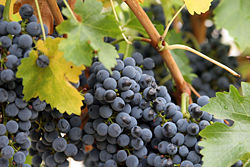
A grape is the non-climacteric fruit that grows on the perennial and deciduous woody vines of the genus Vitis. Grapes can be eaten raw or used for making jam, juice, jelly, vinegar, wine and grape seed oil.
Description
Grapes grow in clusters of 6 to 300, and can be black, blue, golden, green, purple, red, pink, brown, peach or white. White grapes are evolutionarily derived from the red grape. Mutations in two regulatory genes turn off production of anthocyanin, which is responsible for the color of the red grape.[1].
Grapevines

Most grapes come from cultivars of Vitis vinifera, the European grapevine native to the Mediterranean and Central Asia. Minor amounts of fruit and wine come from American and Asian species such as :
- Vitis labrusca, the North American table and grape juice grapevines, sometimes used for wine. Native to the Eastern United States and Canada.
- Vitis riparia, a wild vine of North America, sometimes used for winemaking and for jam. Native to the entire Eastern U.S. and north to Quebec.
- Vitis rotundifolia, the muscadines, used for jams and wine. Native to the Southeastern United States from Delaware to the Gulf of Mexico.
- Vitis vulpina Frost grape. Native to the Midwest east to the coast up through New York.
- Vitis amurensis Most important Asian species.
The sea grape Coccoloba uvifera is actually a member of the Buckwheat family Polygonaceae and is native to the islands of the Caribbean Sea.
Distribution and production
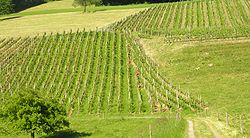
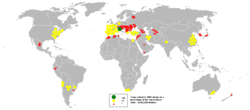
According to the "Food and Agriculture Organization" (FAO), 75,866 square kilometres of the world are dedicated to grapes. Approximately 71% of world grape production is used for wine, 27% as fresh fruit, and 2% as dried fruit. A portion of grape production goes to producing grape juice to be used as a sweetener for fruits canned "with no added sugar" and "100% natural". The area dedicated to vineyards is increasing by about 2% per year.
The following table of top wine-producers shows the corresponding areas dedicated to grapes for wine making:
| Country | Area Dedicated |
|---|---|
| Spain | 11,750 km² |
| France | 8,640 km² |
| Italy | 8,270 km² |
| Turkey | 8,120 km² |
| United States | 4,150 km² |
| Iran | 2,860 km² |
| Romania | 2,480 km² |
| Portugal | 2,160 km² |
| Argentina | 2,080 km² |
| Australia | 1,642 km² |
| England | 10.53 km² |
Sources: FAO, Organisation Internationale de la Vigne et du Vin (pdf), Australian Wine and Brandy Corporation.
Seedless grapes
Seedlessness is a highly desirable subjective quality in table grape selection, and seedless cultivars now make up the overwhelming majority of table grape plantings. Because grapevines are vegetatively propagated by cuttings, the lack of seeds does not present a problem for reproduction. It is, however, an issue for breeders, who must either use a seeded variety as the female parent or rescue embryos early in development using tissue culture techniques.
There are several sources of the seedlessness trait, and essentially all commercial cultivators get it from one of three sources: Thompson Seedless, Russian Seedless, and Black Monukka. All are cultivars of Vitis vinifera.
Contrary to the improved eating quality of seedlessness is the loss of potential health benefits provided by the enriched phytochemical content of grape seeds[2][3]. (see Health Claims below)
Raisins, currants, and sultanas
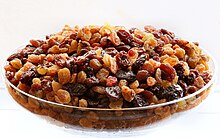
In most of Europe, dried grapes are universally referred to as 'raisins' or the local equivalent. In the UK, three different varieties are recognised, forcing the EU to use the term "Dried vine fruit" in official documents.
A raisin is any dried grape. While raisin is a French loanword, the word in French refers to the fresh fruit; grappe (whence the English grape is derived) refers to the bunch (as in une grappe de raisins).
A currant is a dried Zante grape, the name being a corruption of the French raisin de Corinthe (Corinth grape). Note also that currant has come to refer also to the blackcurrant and redcurrant, two berries completely unrelated to grapes.
A sultana was originally a raisin made from a specific type of grape of Turkish origin, but the word is now applied to raisins made from common grapes and chemically treated to resemble the traditional sultana.
Health claims
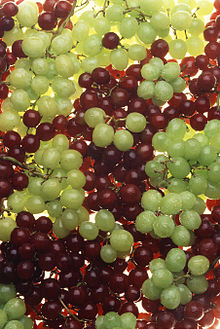
Comparing diets among western countries, researchers have discovered that although the French tend to eat higher levels of animal fat, surprisingly the incidence of heart disease remains low in France, a phenomenon named the French Paradox thought to occur from protective benefits of regularly consuming red wine. Apart from potential benefits of alcohol itself, including reduced platelet aggregation and vasodilation[4], polyphenols (e.g., resveratrol) mainly in the grape skin provide other suspected health benefits, such as[5]
- alteration of molecular mechanisms in blood vessels, reducing susceptibility to vascular damage
- decreased activity of angiotensin, a systemic hormone causing blood vessel constriction
- increased production of the vasodilator hormone, nitric oxide (endothelium-derived relaxing factor)
Doctors do not recommend excessive consumption of red wine, but one glass a day for women and two for men may confer health benefits[6].
Compounds such as resveratrol (a polyphenol antioxidant) have been discovered in grapes and these have been positively linked to fighting cancer, heart disease, degenerative nerve disease and other ailments. Synthesized by many plants, resveratrol apparently serves antifungal and other defensive properties. Dietary resveratrol has been shown to modulate the metabolism of lipids and to inhibit oxidation of low-density lipoproteins and aggregation of platelets.[7]
Resveratrol is found in wide amounts among grape varieties, primarily in their skins and seeds which, in muscadine grapes, have about one hundred times higher concentration than pulp[8]. Fresh grape skin contains about 50 to 100 micrograms of resveratrol per gram[9].
Anthocyanins tend to be the main polyphenolics in red grapes whereas flavan-3-ols (e.g., catechins) are the more abundant phenolic in white varieties[10]. Total phenolic content, an index of dietary antioxidant strength, is higher in red varieties due almost entirely to anthocyanin density in red grape skin compared to absence of anthocyanins in white grape skin[11]. It is these anthocyanins that are attracting the efforts of scientists to define their properties for human health[12]. Phenolic content of grape skin varies with cultivar, soil composition, climate, geographic origin, and cultivation practices or exposure to diseases, such as fungal infections.
Red wine offers health benefits moreso than white because many beneficial compounds are present in grape skin, and only red wine is fermented with skins. The amount of fermentation time a wine spends in contact with grape skins is an important determinant of its resveratrol content.[2] Ordinary non-muscadine red wine contains between 0.2 and 5.8 mg/L [13], depending on the grape variety, because it is fermented with the skins, allowing the wine to absorb the resveratrol. By contrast, a white wine contains lower phenolic contents because it is fermented after removal of skins.
Wines produced from muscadine grapes may contain more than 40 mg/L, an exceptional phenolic content.[14] [3]. In muscadine skins, ellagic acid, myricetin, quercetin, kaempferol, and trans-resveratrol are major phenolics[15]. Contrary to previous results, ellagic acid and not resveratrol is the major phenolic in muscadine grapes.
Since the 1980s, biochemical and medical studies have demonstrated powerful antioxidant properties of grape seed oligomeric proanthocyanidins[16]. Together with tannins, polyphenols and polyunsaturated fatty acids, these seed constituents display inhibitory activities against several experimental disease models, including cancer, heart failure and other disorders of oxidative stress[17][18]. Grape seed oil from crushed seeds is used for many perceived health benefits.
Grapes are fun
See also
External links
- Integrated Taxonomic Information System entry for Grape family
- Area under vine (pdf)
- Wild Grapes
- 300 Grape Varieties for Wine
- Wine Wiki
- SAFECROP - Proceedings of the 5th International Workshop on Grapevine Downy and Powdery Mildew
References
- ^ Walker AR, Lee E, Bogs J, McDavid DA, Thomas MR, Robinson SP (2007). "White grapes arose through the mutation of two similar and adjacent regulatory genes". Plant J. 49 (5): 772–85. PMID 17316172.
{{cite journal}}: CS1 maint: multiple names: authors list (link) - ^ Shi J, Yu J, Pohorly JE, Kakuda Y. (2003 Winter). "Polyphenolics in grape seeds-biochemistry and functionality". J Med Food. 2003 Winter;6(4):291-9. Retrieved 2007-08-16.
{{cite journal}}: Check date values in:|date=(help); Cite journal requires|journal=(help)CS1 maint: multiple names: authors list (link) - ^ Parry J, Su L, Moore J, Cheng Z, Luther M, Rao JN, Wang JY, Yu LL. (2006-05-31). "Chemical compositions, antioxidant capacities, and antiproliferative activities of selected fruit seed flours". J Agric Food Chem. 2006 May 31;54(11):3773-8. Retrieved 2007-08-16.
{{cite journal}}: Cite journal requires|journal=(help)CS1 maint: multiple names: authors list (link) - ^ Providência R. (2006). Cardiovascular protection from alcoholic drinks: scientific basis of the French Paradox. Rev Port Cardiol. 2006 Nov;25(11):1043-58. Abstract.
- ^ Opie LH, Lecour S. (2007). The red wine hypothesis: from concepts to protective signalling molecules. Eur Heart J. 2007 Jul;28(14):1683-93. Abstract.
- ^ Alcohol. Harvard School of Public Health
- ^ Chan, W. K., & Delucchi, A. B. (2000). Resveratrol, a red wine constituent, is a mechanism-based inactivator of cytochrome P450 3A4. Life Sci 67 (25): 3103-3112. Abstract.
- ^ LeBlanc, MR (2005). Cultivar, Juice Extraction, Ultra Violet Irradiation and Storage Influence the Stilbene Content of Muscadine Grapes (Vitis Rotundifolia Michx.). PhD Dissertation, Louisiana State University
- ^ Li X, Wu B, Wang L, Li S. (2006). Extractable amounts of trans-resveratrol in seed and berry skin in Vitis evaluated at the germplasm level. J Agric Food Chem. 2006 Nov 15;54(23):8804-11. Abstract.
- ^ Cantos E, Espín JC, Tomás-Barberán FA. (2002). Varietal differences among the polyphenol profiles of seven table grape cultivars studied by LC-DAD-MS-MS. J Agric Food Chem. 2002 Sep 25;50(20):5691-6. Abstract.
- ^ Cantos E, Espín JC, Tomás-Barberán FA. (2002). Varietal differences among the polyphenol profiles of seven table grape cultivars studied by LC-DAD-MS-MS. J Agric Food Chem. 2002 Sep 25;50(20):5691-6. Abstract.
- ^ Gross PM (2007). Scientists zero in on health benefits of berry pigments. Natural Products Information Center 2007 Jul 9. [1]
- ^ Gu X, Creasy L, Kester A, et al., Capillary electrophoretic determination of resveratrol in wines. J Agric Food Chem 47:3323-3277, 1999
- ^ Ector BJ, Magee JB, Hegwood CP, Coign MJ. Resveratrol Concentration in Muscadine Berries, Juice, Pomace, Purees, Seeds, and Wines. http://www.ajevonline.org/cgi/content/abstract/47/1/57
- ^ Pastrana-Bonilla E, Akoh CC, Sellappan S, Krewer G. (2003). Phenolic content and antioxidant capacity of muscadine grapes. J Agric Food Chem. 2003 Aug 27;51(18):5497-503. Abstract.
- ^ Bagchi D, Bagchi M, Stohs SJ, Das DK, Ray SD, Kuszynski CA, Joshi SS, Pruess HG. (2000-08-07). "Free radicals and grape seed proanthocyanidin extract: importance in human health and disease prevention". Toxicology. 2000 Aug 7;148(2-3):187-97. Retrieved 2007-08-16.
{{cite journal}}: Cite journal requires|journal=(help)CS1 maint: multiple names: authors list (link) - ^ Agarwal C, Singh RP, Agarwal R. (2002-11-23). "Grape seed extract induces apoptotic death of human prostate carcinoma DU145 cells via caspases activation accompanied by dissipation of mitochondrial membrane potential and cytochrome c release". Carcinogenesis. 2002 Nov;23(11):1869-76. Retrieved 2007-08-16.
{{cite journal}}: Cite journal requires|journal=(help)CS1 maint: multiple names: authors list (link) - ^ Bagchi D, Sen CK, Ray SD, Das DK, Bagchi M, Preuss HG, Vinson JA. (2003-02-01). "Molecular mechanisms of cardioprotection by a novel grape seed proanthocyanidin extract". Mutat Res. 2003 Feb-Mar;523-524:87-97. Retrieved 2007-08-16.
{{cite journal}}: Cite journal requires|journal=(help)CS1 maint: multiple names: authors list (link)
